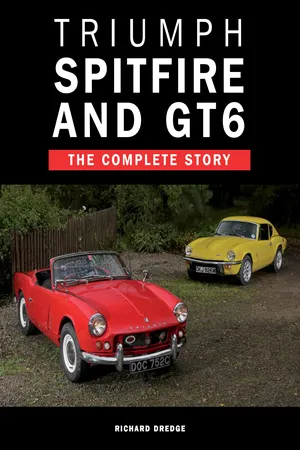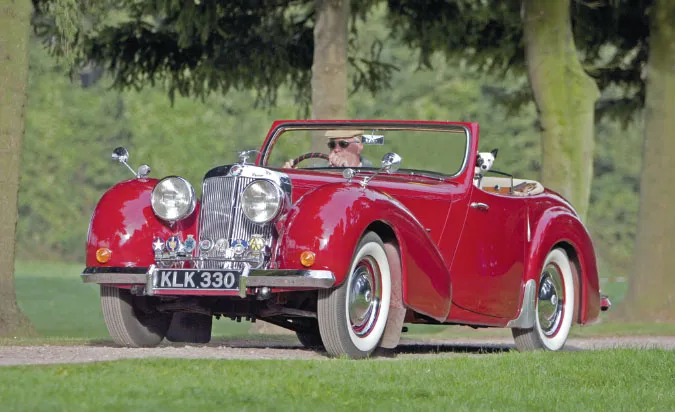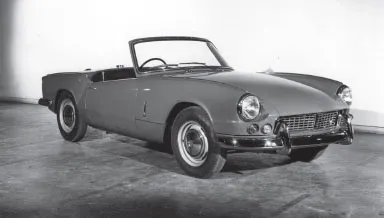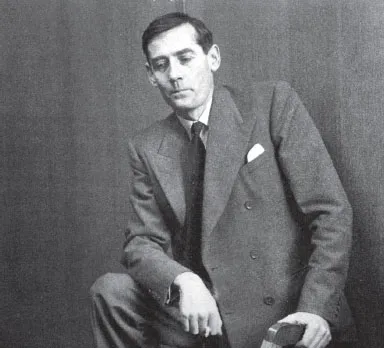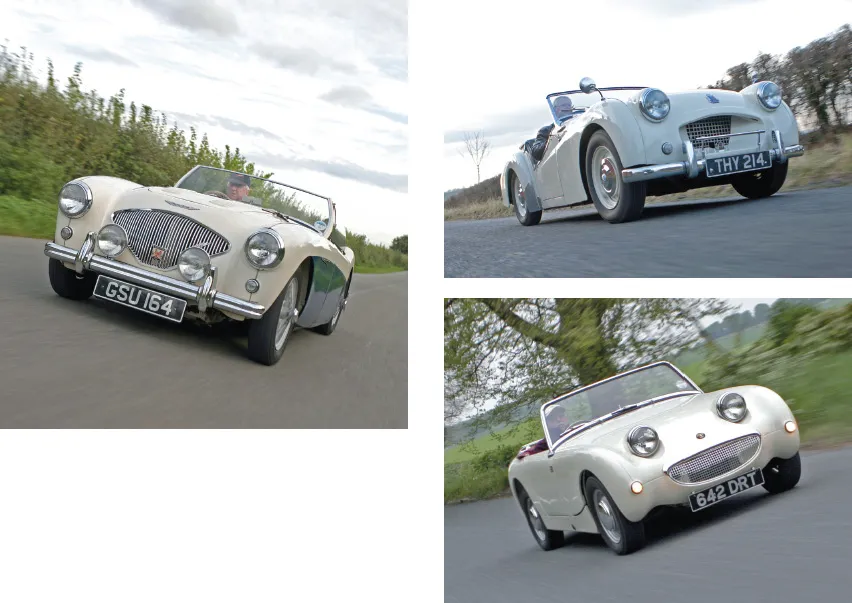![]()
CHAPTER ONE
INTRODUCTION
If it hadn’t been for the Austin Healey Frogeye Sprite, would Triumph ever have embarked on producing its own cheap sports car? Possibly not. Until the arrival of the Frogeye, sports cars were invariably big, costly and produced in relatively small numbers. Even those sports cars which weren’t big and costly were invariably rare, usually produced by specialist car companies, which either revived ancient pre-war cars with a new glass fibre bodyshell, or which inserted the mechanicals from some contemporary family car (usually a Ford) and wrapped them up in their own bodywork. However, these cars were often fragile, poorly made, or simply too costly to be truly affordable to the masses. What was needed was a mainstream car maker to introduce something that was fun to drive, cheap and well supported by a large dealer network. When Austin Healey did it with the Sprite, it was only natural that somebody else would try to emulate the company’s success – and that rival was Triumph, with its Spitfire.
Triumph is still one of the world’s best-loved marques, yet many years have passed since its demise. The company built cars for just 65 years, starting in 1923, then disappeared into the annals of time with the demise of a badge-engineered Honda, in 1984. Sure, Triumph as a brand existed far longer, as it built push bikes and motorcycles before branching out into cars. But as a car builder it wasn’t really around all that long – yet it is still one of the best-supported motoring marques around, thanks to enthusiastic clubs and a raft of great models over the years.
Perhaps one of the greatest reasons for the marque’s popularity is the success of the TR range in America. But models such as the Herald, Vitesse, Spitfire and GT6 also played their part, between them providing affordable family transport or sporting fun, depending on the model. However, it might not have been that way, after Triumph as a car maker almost disappeared from sight in the 1930s.
This was as sporty as things got for Triumph in the post-war years. Still, the 1800 and 2000 Roadsters were undeniably stylish.
It was in 1921 that Triumph purchased the Coventry factory of failed car builder Dawson, with a view to starting up the manufacture of Triumph-branded cars. At that time the company was owned by Siegfried Bettmann, assisted by his general manager Claude Holbrook. Up until this point, Triumph had focused purely on building bikes, with and without motive power attached; buying up the Dawson plant would enable the firm to move up several gears in one go.
By 1923 Triumph had its first car on the market, the 1393cc 4-cylinder 10/20. Designed by Arthur Alderson, who was working for Lea-Francis at the time, the car was costly at £430-£460, the price boosted by the fact that Triumph had to pay Lea-Francis a royalty on each car sold. There then followed a succession of cars that had little to lift them above their rivals, but in 1928 came the breakthrough model, the Super Seven. Very much in the mould of Austin’s rival Seven, Triumph’s new baby car was designed by Stanley Edge, who had helped Herbert Austin realize the identically-named car that saved his company from the mire. The Triumph Super Seven didn’t enjoy the racing successes of its Austin and MG (Midget) rivals, but that didn’t stop it from being highly successful, with more than 17,000 finding owners between 1928 and 1932.
Despite the relative success of the Super Seven, Holbrook decided that he would take Triumph upmarket in the 1930s – a move that would prove disastrous. In 1931 came Triumph’s first six-cylinder car, the Scorpion, which sold poorly because of its stodgy handling. Then in 1933, Holbrook decided he would start to buy in Coventry-Climax engines instead of developing his own fresh powerplant, in-house. There followed a line of cars that were designed to take on Riley, Alvis and SS, the most ambitious of which was the 1934 Dolomite, complete with a straight-eight in the nose.
SPITFIRE PROTOTYPES
• | There were four Spitfire prototypes built using experimental chassis numbers (with an X-prefix). The first was X659, built by Michelotti in Italy, in October 1960 and based on a modified Herald coupé chassis. This car, which carried the Bomb nickname, was fitted with a 948cc powerplant carrying engine number X854. |
• | The next prototype was a development car, which carried chassis number X661. Constructed towards the end of 1960, this car was once again based on a modified Herald coupé (this time the whole bodyshell was shortened, rather than just the chassis). The original engine number isn’t known, but this car would later be fitted with a production 1147cc engine, carrying number GA 57428. |
• | It was early in 1962 that the first pre-production Spitfire prototype was built, bearing chassis number X691. Constructed in Coventry, this was the first prototype to be road registered (4305 VC) and it was also the first to feature the final production details with regard to styling. The original engine number isn’t recorded, but X691 would later be fitted with an 1147cc unit, carrying number HE18491HE. This car would also go on to be developed into the fastback prototype that would be the precursor to the GT6; it would also be used for mechanical development including the installation of fuel injection. |
• | The final prototype was X692, which would be the most familiar to Triumph fans of the period. Constructed around the same time as X691, this car would be registered as 412 VC, and not only would it go on to be a well-travelled press car, but it would also be used for endurance testing and rallying. From the outset, the car was fitted with an 1147cc engine, carrying number FC 2 HE. Intriguingly though, the car would be constructed with right-hand drive, and it would then be converted to left-hand drive, only to revert to the original configuration ready for its rallying début in 1964. |
The first Spitfire prototype, pictured in October 1960.
In 1937 there was a return to in-house engines for Triumph, each one being designed by Donald Healey. Available with displacements of 1496cc, 1767cc or 1991cc (the last having six cylinders), there was from this point on a rather bewildering array of cars available. Because the 1232cc Coventry- Climax powerplant was still offered in the entry-level cars, there were four engines available across three ranges: Gloria, Vitesse and Dolomite. By 1936 Triumph was posting big losses, and by June 1939 the company was bankrupt.
It wasn’t until 1944 that Triumph emerged from the ashes – literally – when Standard’s Sir John Black bought the Triumph name and what remained of the factory, after it had been all but destroyed during the War. The site was quickly sold, with Triumph production being integrated with Standard’s existing facility at Canley, near Coventry. The first cars were the 1800 (Razoredge) saloon and Roadster, equipped with 1776cc 4-cylinder engines, with bodywork by Mulliners of Birmingham. Triumph wasn’t completely out of the woods yet, but it looked as though the worst was over, with sales picking up and a whole stream of fresh models introduced over the next few years.
The next big step was the introduction of the TRX in 1949, which signalled Triumph’s intention to exploit the two-seater sports car market. However, the TRX was too complex, as it featured a power-operated roof, windows and seats, along with pop-up headlamps (this was 1949 remember…). There was no way it could have been built economically, while reliability would be an issue without a doubt. What was needed was something much simpler, that had charm and rugged performance and which could be built and sold at a low price. That car was the TR2, which served as a prelude for perhaps the greatest succession of sports cars ever, from the TR2 to the TR6 – and maybe even the TR7 if we’re being charitable…
ALICK DICK
Alick Dick was the managing director of Standard-Triumph during its most interesting period, between 1954 and 1961, when he was replaced by Stanley Markland (who would stay at the company for just two years). Responsible for overseeing the development of the early TRs, Dick also oversaw the launch of the Standard Eight, later Vanguards, plus the Herald.
Alick Sydney Dick was born in Norfolk in 1917, the son of a doctor; by 1934 he was an apprentice at the Standard Motor Company. It was clear from the outset that he had great potential as a manager and by the outbreak of the Second World War he had been promoted to chief buyer for the company’s aero-engine factories.
Alick Dick was in charge of Standard-Triumph from 1954 until 1961.
As soon as Standard took over Triumph, Dick was promoted to the position of personal assistant to Sir John Black, who was then managing director of Standard-Triumph. From there his rise through the ranks was swift: by 1947 Dick was assistant managing director and in 1951 he was made deputy managing director. Dick had made more rapid progress than older, longer-serving members of staff around him – but the best was yet to come.
By 1954 there was some dissatisfaction with Black’s leadership style: he was seen as dictatorial, and keen to overshadow those around him. It came as no surprise therefore when Dick led a coup to oust Black as managing director of the company – a move that was to initially prove successful for everyone concerned.
However, although sales at first went from strength to strength, the good times didn’t last and Standard-Triumph was taken over by Leyland Motors in 1961. Within months, Dick was forced to move on. At first he did very little work-wise, but by 1963 he was managing director of electronics outfit Royston Instruments. By 1968 Dick had left Royston to become a consultant to Volkswagen, based in Coventry. He died in March 1986, aged sixty-nine.
Triumph’s first post-war sports cars were the sidescreen TRs (top right), which were fast, stylish and reliable, but they were also too costly for many. The main rival to these was the Austin Healey 100 (above); sitting below this was the ultra-cheap Sprite, initially in ‘Frogeye’ form (right). What Triumph needed was an affordable roadster to take on the Sprite – and the Spitfire was just such a car.
But we’re jumping ahead of ourselves now; we need to step back to the late fifties, when Britain led the world in motoring design and mass production, whether it was mundane family saloons or something rather more exciting. In an age when platform-sharing is the norm if the production costs are to add up, you’ll soon see that the concept is far from new. Barely more than a decade after the end of the Second World War, Triumph was already thinking about how it could produce a series of cars all using the same basic platform and the same set of mechanical components.
The car that set the ball rolling was Triumph’s Herald, which was unveiled in April 1959. Many questioned the decision behind introducing a car with such an outdated construction; even at this time, a separate chassis was decidedly passé for a mass-produced car, and thus the new family saloon appeared to be a throwback to the post-war era. However, there was a method in Triumph’s apparent madness; it was aiming to introduce a whole family of Heralds, while in theory it would also be possible to engineer something smaller and rather more sporty. Where Austin Healey had its 100, Triumph had its TR2 and TR3 to compete, but something much more affordable was needed to take on the Sprite, as well as MG’s Midget. That car would be the Spitfire, while later would come the GT6.
Just like the Herald, the Spitfire was designed by Giovanni Michelotti, who had been drafted in as Triumph’s design consultant after the departure of Standard’s previous designer, Walter Belgrove. Belgrove had designed the early TRs, which had proved phenomenally successful for Triumph, but he left after a disagreement with some of Triumph’s decisions, leaving the company without anybody to pen its key forthcoming models. American designer Carl Otto was commissioned to design the Standard Vanguard III, but it was clear that somebody needed to be found to give Triumph a new design direction.
That person was Michelotti, who was found purely by chance. Indeed, it wasn’t even Triumph’s Harry Webster who made the discovery; it was one of his business contacts, who happened to disclose in conversation that he knew of a styling house which could design and build prototypes in an astonishingly short space of time. Webster loo...
